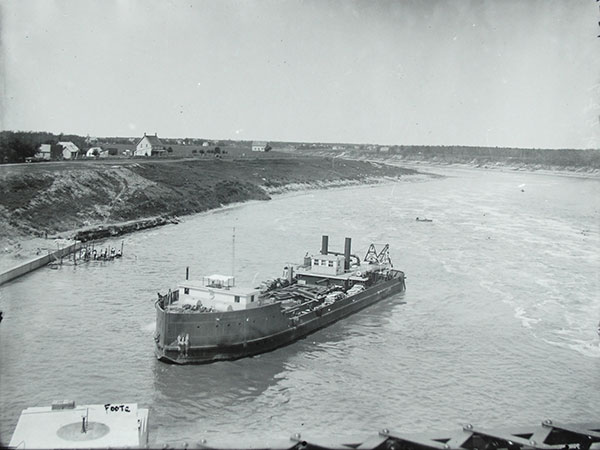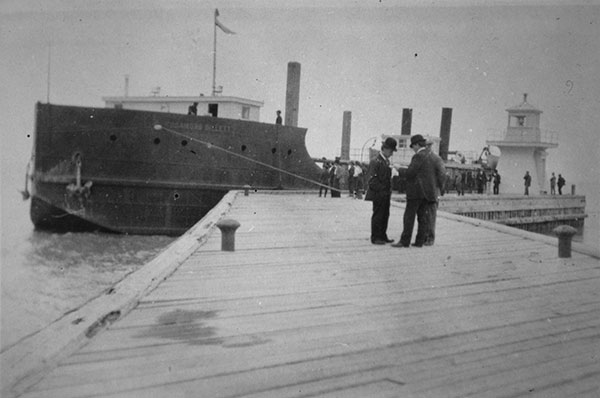In 1910, the Eli Sand Company (ESC) commissioned a gigantic, self-propelled, multi-purpose sand dredging barge based on designs of Toronto naval architect W. E. Redway. Construction took place in Winnipeg on the western bank of the Red River, situated at the foot of Water Street, and just north of the fixed-span Broadway Bridge. Designated as Towing Barge No. 1 during the design phase, the otherwise unnamed ship was laid down on stocks during the spring of 1910. Work was overseen by shipwright A. A. Hackett (of Wiarton, Ontario) and undertaken the local Doty Engine Company. The sides were completely riveted steel and painted, with the hull bottom of heavy wooden make. Overall dimensions measured 170 feet long, 40 feet wide, and 13 feet deep. Grosse tonnage registered at 679 tons. The ships crew totalled eight, an the Captain had his quarters located on the front deck.
Within months of ESC’s merger into the Lake Winnipeg Shipping Company (LWSC), the vessel was bestowed with the name of “Rosamond Billett,” in tribute to the granddaughter of LWSC’s President Hugh McKay Sutherland. Mary Rosamond Billett (who went by her middle name) was born in the United States on 25 August 1902, the daughter of Thomas Richard Billett and Florence Anna Sutherland (c1872-1917). She grew up in Winnipeg and graduated from Mulvey School with honours in 1916, with further studies at taken at Macdonald College (c1920). In 1922, she returned to home and took training as a nurse at the Children’s Hospital of Winnipeg. Within two months of her father’s 1936 death, she moved to British Columbia and settled in Victoria, later working as a social worker from around 1942 until her own passing. She died, unmarried, at Jubilee Hospital in Victoria on 28 June 1947 and was buried in Royal Oak Burial Park.
An official launching ceremony was held on 10 Oct 1910, at which Rosamond officially christening her namesake with a bottle of champagne. The order was then given by Redway to release the restraints, and the vessel traversed the short distance from its shore berth into the Red River. The reportedly quiet launching was aided by no less than three coats of lubricant upon the slipway, comprised of two heavy coats of tallow, and one of soft soap. “Sea” trials began within two weeks. The vessel initially wintered at the LWSC Docks site. Further components were installed in the spring of 1911 to aide on and off-landing of cargo, with design completion then being fully executed. Her unit price tag represented an investment of $85,000, and as of that time was the largest self-powered vessel in the Red River.
Heralded as a ship class unto her own within North America, she was self-powered by a twin fore and aft compound engine (cylinders : 13 inches, 26 inch diameter, 18 inch stroke) and a centrifugal-type suction bore (12 inch diameter). The independent compound marine engine (cylinders: 8 and 16 inch diameters, 12 inch stroke) was powered by a Scotch Marine type boilers capably of 150 pounds per square inch. Her steering was via two propellers, each with accompanying rudder, and the ship sported electrical lighting. The vessel dimensions made near-maximum capacity of the newly expanded St. Andrew’s Locks. At the time, the phrase “lock sized” was used to describe vessels built to maximize allowances for navigation through said locks. Her total capacity was nearly 1,000 tons, with each of the separate three 330-ton capacity hoppers surrounded by their own reinforced buoyancy chamber. In addition to her own cargo load, she was also capable of towing her own two barges, each with an additional 500 ton capacity. By June 1911, the LWSC had sister barge [Barge No. 2, unnamed] already under construction and a third [Barge No. 3, unnamed] slated to laid down shortly thereafter. Several others, of differing sizes, were to follow in the next two years.
Of the grand vision which brought forth its creation, reality was less favourable. The vessel remained in active service of the LWSC into 1913, when it was damaged in the spring ice runoff on the Red River. During the early morning hours on 11 April 1913, the vessel was among many others damaged via a rush of ice on the Red River. The ice flow caught the Rosamond Billett (which was under steam at the time) at the LWSC Docks and caused her to break free of all her 2.5 and 4 inch rope moorings as well as 1.25 inch steel cables. She was then pushed into a new LWSC barge (measuring 190 feet long, 40 feet wide, 10 feet deep) tied up immediately downstream of her. Heading with the current, both then impacted the SS Alberta. The Rosamond Billett’s crew, led by Chief Engineer Rennie, underwent emergency procedures; including both dropping anchors as well as anchor spills (where timbers are driven through the designed holes in the bottom of the hull, in intention to make contact with the river bottom and thus holdfast a vessel in place. Their efforts were to no avail, and both vessels continued towards the Canadian Pacific Railway Main Line Bridge. Here the other barge collided with the bridge’s east stone pier. The crash, which heavily ruined the unnamed barge bow, also swung the vessel around and created a makeshift barrier to block both ice and watercraft alike. It would take a gang of carpenters over a day to dislodge the barge. The damage sustained to Rosamond Billett in this event was not highlighted in newspaper reports, and mention of commercial activity involving her beyond that occurrence has not yet been uncovered. The vessel remained in or around Winnipeg until 1917, when she was broken up, with salvaged components being shipped east to the Great Lakes and St. Lawrence Seaway region. There they were incorporated into a new hull of the SS T. P. Phelan. This successor too had a short lifespan. Laid down at the Tidewater Shipbuilders Limited yard at Trois Rivieres, Quebec in 1917, it foundered in the St. Lawrence Seaway in 1920. It was sold, salvaged, and rebuilt, remaining in service until it was scrapped completely in 1922.

Construction of the Rosamond Billett (1910)
Source: Rob McInnes, WP2099

Launching of the Rosamond Billett at Winnipeg (October 1910)
Source: Archives of Manitoba, Loudon G. Wilson fonds, PR1978-14, #197.

Rosamond Billett immediately north of the St. Andrew’s Locks (July 1912)
Source: Archives of Manitoba, L. B. Foote fonds, #665.

Rosamond Billett lying outside breakwater at Gimli Harbour, by the Gimli Lighthouse (c1910-1917)
Source: Archives of Manitoba, Loudon G. Wilson fonds, PR1978-14, #198.
Period
Owner
1910
Eli Sand Company
1910-1917
See also:
Historic Sites of Manitoba: Lake Winnipeg Shipping Company Docks (Winnipeg)
Marriage and death registrations, Manitoba Vital Statistics.
Death registrations, British Columbia Vital Statistics.
1901 & 1911 Canada censes, Automated Genealogy.
1916 Canada census, Library and Archives Canada.
“City and General [Sand company buys property],” Manitoba Free Press, 1 February 1910, page 20.
“News of the day,” Manitoba Free Press, 24 March 1910, page 1.
“To build barge,” Manitoba Free Press, 25 April 1910, page 5.
“A building permit,” Manitoba Free Press, 5 May 1910, page 4.
“Local and General [Eli Sand barge],” Manitoba Free Press, 4 May 1910, page 22.
“Development along the river front [New steel boat for Eli Sand Co. at the foot of Water Street],” Manitoba Free Press, 10 September 1910 page 29.
“First steel barge is launched in Red,” Manitoba Free Press, 11 October 1910, page 20.
“The pioneer steel-plated barge on the Red,” Manitoba Free Press, 12 October 1910, page 4.
“Local notes [In the account of the launching ...],” Manitoba Free Press, 15 October 1910, page 11.
“Local notes [As a result of the dam opening at St. Andrew’s Locks],” Manitoba Free Press, 2 November 1910, page 11.
“Local notes [in view of the approaching shipping season...],” Manitoba Free Press, 4 May 1911, page 20.
“Great activity in navigation on historic Red River,” Winnipeg Tribune, 2 June 1911, page 2.
“Winnipeg as shipbuilding port,” Manitoba Free Press, 3 June 1911, page 27.
“Another barge is going northward with large cargo,” Winnipeg Tribune, 13 June 1911, page 11.
“Of interest to women - Society [Mr. and Mrs. Hugh Sutherland],” Winnipeg Tribune, 16 September 1911, page 9.
“Rush of ice in river plays havoc with big boats,” Manitoba Free Press, 12 April 1913, page 8.
“Selkirk docks are much larger than those of Winnipeg,” Winnipeg Tribune, 12 July 1913, page 20.
“Takes honors in Examination [Miss Rosamond Billett],” Winnipeg Tribune, 7 July 1916, page 6.
“Social and personal [Miss Rosamond Billett],” Manitoba Free Press, 21 December 1920, page 18.
“Winnipeg girls seek careers in hospitals,” Winnipeg Tribune, 22 April 1922, page 9.
“Society [Miss Rosamond Billett],” Winnipeg Tribune, 16 September 1929, page 6.
“Society [Miss Rosamund Billett, sic],” Winnipeg Tribune, 18 February 1936, page 8.
“Social worker dies,” Winnipeg Free Press, 3 July 1947, page 6.
The New Mills' List - Registered Canadian Steamships 1817-1930 over 75 feet, Rosamond Billett (Official Number 130272), Queen's University.
This page was prepared by Nathan Kramer.
Page revised: 12 February 2022